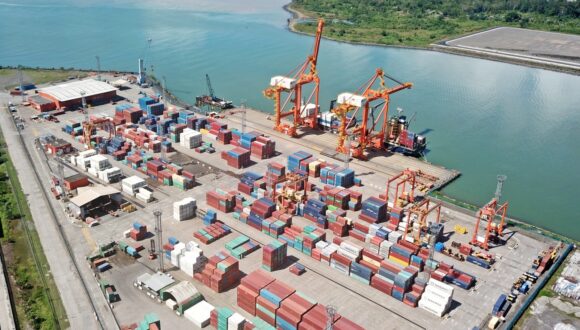After a challenging 2023, Papua New Guinea’s port and road transport operators are preparing for a significant recovery in demand this year.

Lae port. Credit: ICTSI
Papua New Guinea’s logistics companies made the most of a quiet 2023 by doubling down on maintenance and investing in new vessels and equipment, in preparation for an expected increase in demand this year.
Steamships Trading Company, International Container Terminal Services Inc (ICTSI) and PNG Ports Corporation have all made significant investments to expand services and boost efficiency ahead of the final investment decision for the TotalEnergies-led Papua LNG project, expected next year.
“We’re relatively confident about the market coming back, not just because of the [Papua LNG] final investnent decision [FID], but we’re confident of underlying volumes coming back in 2024,” said Chris Daniells, Steamships’ Chief Operating Officer. “Market sentiment is more positive than it has been for a while.”
Steamships has added two vessels and three new tugboat and barge combinations, increasing its mainline capacity by 25% to prepare for growth.
Additional capacity
While it awaits FID, Steamships will use its additional capacity to restore weekly sailings between Lae and Port Moresby, Daniells tells Business Advantage PNG. It used the dip in demand in 2023 to focus on maintenance programs for its vessels and fleet of trucks, and invested in quality improvements at its workshops in Port Moresby and Lae.
Meanwhile, ICTSI South Pacific (operator of PNG’s two international ports, Motukea and Lae) has also focused on efficiency gains. Additional ship-to-shore cranes in Lae are reducing discharging and loading times, achieving faster vessel turn-around times, and improving safety, according to CEO Robert Maxwell.
“This is evidenced by an increase in trans-shipments, with Lae starting to become a trans-shipment hub for the region, particularly for cargo going to and from the Solomon Islands and Vanuatu,” says Maxwell.
He expects freight volume to increase 5 to 6 per cent this year, based on the advancement of Papua LNG, the restarting of Porgera and the beginning of Wafi-Golpu.
“We’re relatively confident about the market coming back … Market sentiment is more positive than it has been for a while.”
Efficiency and emissions
Maxwell also notes ICTSI is committed to reducing emissions by deploying solar panels, converting terminal lighting to LEDs, and using of rain-harvesting technology in Lae.
“In terms of emissions, the big one for us is efficiency within the terminal,” he said. “Ship-to-shore cranes in Lae can lift two twenty-foot containers simultaneously, instead of one at a time, which reduces the net emissions per container.”
Lae is PNG’s busiest port, handling 54 per cent of PNG’s trade volumes, followed by Port Moresby (21 per cent) and Kimbe in West New Britain (7 per cent).
Meanwhile, ICTSI’s landlord, PNG Ports Corporation, has an extensive US$412 million investment program to upgrade and expand PNG’s 15 major ports, which between them handle about 10 million tonnes of cargo a year.
The largest of these is the US$176 million phase 2 development of the Lae Tidal Basin “with the aim of developing the area into an industrial hub, ready for the boom in the resource sector,” says Ian Hayden-Smart, Officer in Charge at the state-owned company.
This article was first published in the 2024 edition of Business Advantage Papua New Guinea, PNG’s leading business and investment guide.








Speak Your Mind